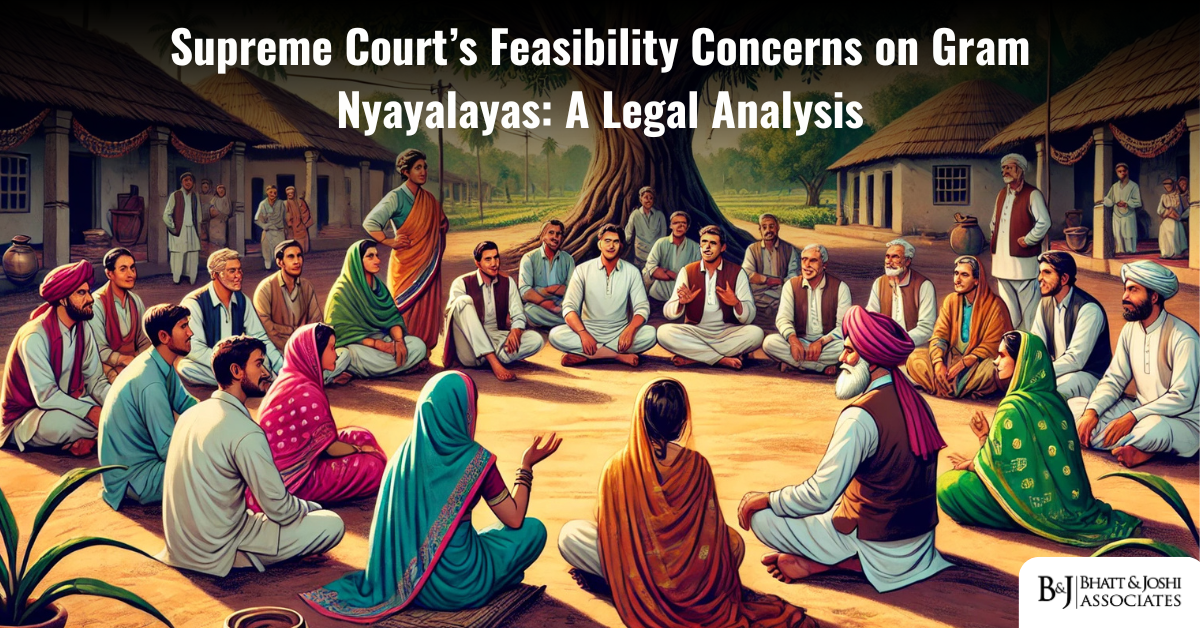Introduction
The concept of Gram Nyayalayas, or village courts was introduced into India to offer accessible, cost-effective and prompt justice to the rural populace. With over two-thirds of India’s total population residing in rural areas, the need for decentralised legal mechanisms arose as a means of addressing the inequities and delays of the inefficient traditional judicial systems. Howeve,r despite the noble intentions underlying their inception, Gram Nyayalayas have struggled to fully achieve their intended purpose. The Supreme Court of India has raised pertinent concerns about the functionality, sustainability and compliance with constitutional issues surrounding Gram Nyayalayas. This article will delve into the legislative framework, regulatory mechanisms, judicial interpretations as well as the feasibility concerns raised by the Supreme Court over Gram Nyayalayas, providing a detailed explanation of their challenges and the possible ways forward with the issue.
Legislative Framework for Gram Nyayalayas
The establishment of the Gram Nyayalayas at the village courts level was aimed to be achieved by The Gram Nyayalayas Act of 2008 which came into effect to create specific civil and criminal jurisdiction at the village level. These courts were expected to relieve the higher courts of their workload and offer justice at the local level. The Act empowers state governments to set up Gram Nyayalayas, which are to be presided over by a Nyayadhikari (judicial officer), who shall be appointed by the state in consultation with the High Court.
In case of prosecution of a particular offence, the Gram Nyayalayas, as far as the jurisdiction is concerned, are tantamount to the Judicial Magistrates of the First Class, and in addition, they have jurisdiction over some civil matters, for instance, matters relating to property, family, and tenancy. They are expected to operate with the least formality and are governed by natural justice instead of formalistic procedural codes, including the Code of Civil Procedure 1908 (CPC) and the Code of Criminal Procedure of 1973 (CrPC). This simplification of procedures was meant to permit the rural population, the majority of whom do not have the means to afford legal representation, to easily access the justice system.
Objectives of the Gram Nyayalayas Act, 2008
The relief efforts contained in the Gram Nyayalayas Act seek to bring justice to the rural population, reduce the backlog in ordinary courts, deliver justice more cheaply and efficiently, and encourage other forms of conflict resolution such as conciliation and mediation. The Act sought to improve access to justice by establishing the courts within reach of rural population centres, thus eliminating previously existing geographical and economic constraints.
The opening of these courts has however proved to be difficult in practice. These issues have led to judicial interventions, with the Supreme Court investigating their practicality and use. Appreciating the rationale of the law is crucial in understanding the problems of its execution and the Supreme Court’s apprehensions.
Supreme Court’s Concerns
The Supreme Court of India has overseen the implementation of Gram Nyayalayas and pointed out the gaps in its execution. Among the concerns mentioned were the lack of establishment of courts by state governments, the lack of adequate infrastructure, budgetary constraints, vague procedures, and low levels of public knowledge and faith.
The lack of compliance of state governments, particularly in the establishment of the courts, was and continues to be a major concern for the Supreme Court. Political and administrative apathy to establish the courts make it impossible to live up to the requisites of the Gram Nyayalayas Act. In 2010, the Supreme Court in the case of All India Judges Association vs Union of India pointed out the great need for proper infrastructure and state support for judicial reforms to have any effect. This includes the establishment of the Gram Nyayalayas.
A subsequent problem that the court mentioned is the lack of adequate facilities and resources. Generally, a Gram Nyayalaya faces challenges like insufficient courtroom space, no available technology, and poor levels of clerical staffing. This situation is worsened by the lack of continuous education for Nyayadhikaris and his or her supporting personnel, which increases the possibility of providing unjust outcomes. In this regard, the court in Imtiyaz Ahmad v. State of Uttar Pradesh (2012) stated that infrastructure and resource support are critical components in the delivery of justice and noted that absent these supports, the Gram Nyayalayas would not serve their purpose.
The scarcity of resources remains a potent barrier to the operationalization of Gram Nyayalayas. Although both the centre and states are expected to contribute as per the provisions of the Act, the frequent non-payment and administrative hold-ups have created serious functional problems. The importance of having sufficient funds, or being able to earn them independently, was discussed in the context of institutions of the judiciary in the case of Supreme Court Legal Aid Committee v. Union of India (1989) when the Judge commented that resource constraints hamper the efficacy of the judicial system and are the root cause of many inadequacies.
Concerns have arisen regarding jurisdiction and procedure. Jurisdiction of Gram Nyayalayas and that of the corresponding regular courts overlap, leading to procedural delays that hamper justice. Furthermore, the informal methods used by Gram Nyayalayas to simplify processes tend, at times, to be simplistically arbitrary. As noted in Salem Advocates Bar Association v. Union of India (2005), the Supreme Court underscored the need for clarity in procedural statutes to minimize legislation disputes and assure equity.
An additional problem is the generally low levels of confidence and knowledge about Gram Nyayalayas. Most people living in the rural parts of the country do not know whether these courts even exist or have some social and cultural reservations about their usefulness. The court in the case of State of Punjab v. Jagdev Singh Talwandi (1984) noted that public confidence is essential for the effective functioning of any judicial institution and emphasised also the importance of legal education for increasing access to justice.
Regulatory Mechanisms and Monitoring
In response to these challenges, the Supreme Court has put in place certain regulatory mechanisms aimed at ensuring the appropriate functioning of Gram Nyayalayas. Within their territorial limits, High Courts are assigned the powers of supervision of Gram Nyayalayas within their jurisdiction, to ensure observance of the principles of natural justice, control the backlog of cases, and redress the complaints that stem from procedural delays.
The Supreme Court has also suggested that programmatic training and capacity-building activities for Nyayadhikaris be designed to bring them up to speed on the legal framework, ADR options, and socio-economic realities of rural parts of the country. These programs are critical towards building judicial officers’ competencies as they relate to the unique demands posed on rural justice delivery.
Another mechanism the court underscored was the periodic reporting by the state as well as the judiciary concerning the activities and effectiveness of the Gram Nyayalayas. In the case of Laxmi Kant Pandey v. Union of India (1984), the court said that there was too much emphasis on the lack of evaluation through monitoring, suggesting that such reports may assist in addressing issues and that policy implementation should be strengthened by making use of data.
Judicial Interpretations and Case Laws
The judiciary has been vitally involved in the interpretation of the scope and application of the Gram Nyayalayas Act 2008. Key judgments include All India Judges Association v. Union of India, (2010), which highlighted the need for judicial reforms to deal with and ease the issue of pendency and to improve access and justice, and Imtiyaz Ahmad v. State of Uttar Pradesh (2012), which underscores the importance to infrastructure allocation and resources required for effective justice delivery by the judiciary. In State of Punjab v. Jagdev Singh Talwandi (1984) the court highlighted the significance of effective legal literacy and public trust in judicial reforms. In Supreme Court Legal Aid Committee v. Union of India (1989) the court took notice of the importance of financial sustainability and government accountability in implementation of judicial regulation.
Challenges in Implementing Gram Nyayalayas
Any feasibility concerns associated with Gram Nyayalayas can be explained to a large extent by several challenges including limited jurisdiction, resistance from legal professionals, cultural and social barriers and coordination issues. There are currently restrictions on the matter of cases that Gram Nyayalayas can hear which has a limit in their ability to be of help and appeal to rural communities. The legal fraternity has shown resistance to the informal procedure adopted by Gram Nyayalayas, particularly regarding informal case matters, this resistance has prevented the adoption of the Gram Nyayalaya procedure by local communities. Deep-rooted socio-cultural norms influencing rural areas in matters related to gender and caste have hindered the ability of Gram Nyayalayas to function effectively allowing their efficiency to be somewhat reduced. Coordination problems which arise between different government levels including central and state government increase the complexity of the implementation of schemes.
Way Forward for Strengthening Gram Nyayalayas
It is necessary to solve the Supreme Court’s concern with a multi-prong strategy. Consolidating technology and infrastructure support, periodic training and awareness programs for judicial personnel, legal awareness about Gram Nyayalayas, modification of the scope of jurisdiction and procedures, and availability of funds along with appropriate expenditure control are all required. These issues can be addressed only through partnership action of the judiciary, the government, and civil society to harness the potential of Gram Nyayalayas as real tools of decentralized justice.
Conclusion
The Supreme Court’s concern over the feasibility of Gram Nyayalayas highlights the need to implement systemic reforms to improve access to justice in rural India. While the Gram Nyayalayas Act 2008 provides a very solid framework for the incorporation of these facilities, the implementation of these facilities has been marred by issues surrounding infrastructure, finance and procedure. By addressing the concerns raised through collaborative efforts an attempt to implement the legislative intentions will lead to improvements whereby Gram Nyayalayas can uphold the principles of justice, gender and equity for all.













